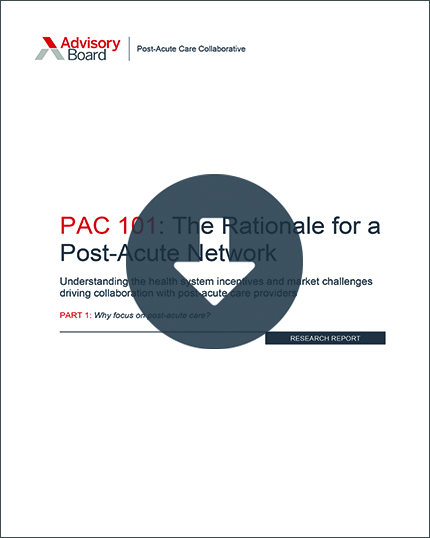Numerous financial incentives exist that promote the close coordination between acute care health systems and post-acute care. We outline the six most impactful of these incentives, their specific impacts and how these incentives warrant a cross-continuum approach.
To learn more about each of these incentives, download our complimentary guide The Rationale for a Post-Acute Network, Part One: Why focus on post-acute care?
Blog Post: The 3 post-acute care partnership structures that promote long-term collaboration
Acute care health systems’ interest in post-acute care partnerships has surged since the Affordable Care Act, and with strong rationale. Post-acute care (PAC) has always played a critical role in health care, providing the rehabilitation and long-term care services necessary to return patients to health. But the divide between hospitals and PAC providers, created by fee-for-service payment, has led to a system where post-acute providers hold vendor-like referral relationships with hospitals rather than relationships that maximize potential for care coordination.
Complimentary Resource
Two strategies on how to best benefit from a strong post-acute care networkFurthermore, acute care administrators have historically lacked significant financial rationale for stronger PAC relationships. Under fee-for-service, preventing readmissions requires administrators to cannibalize hospital volumes, and hiring care coordination staff adds to hospital overhead without generating additional revenue.
The Affordable Care Act has, however, increased the incentives for acute care systems to work closely with post-acute providers. Incentives to reduce hospital length of stay combined with an overall commitment to improvement patient outcomes generated basic alignment with post-acute providers, but readmission penalties, value-based purchasing, and risk-based payment models such as bundled payments and Accountable Care Organizations (ACOs) have raised the importance of post-acute alignment.
Specifically, the following are notable financial incentives for hospitals to align with post-acute providers:
- DRG-Based Hospital Payments
- Readmission Penalties
- Mortality Penalties
- Federal Meaningful Use Requirements
- Patient Satisfaction
- Cost Accountability Programs
Download our guide The Rationale for a Post-Acute Network, Part One: Why focus on post-acute care? to learn more about each of these incentives.
Don't miss out on the latest Advisory Board insights
Create your free account to access 2 resources each month, including the latest research and webinars.
Want access without creating an account?
You have 2 free members-only resources remaining this month remaining this month.
1 free members-only resources remaining this month
1 free members-only resources remaining this month
You've reached your limit of free monthly insights
Become a member to access all of Advisory Board's resources, events, and experts
Never miss out on the latest innovative health care content tailored to you.
Benefits include:
You've reached your limit of free monthly insights



